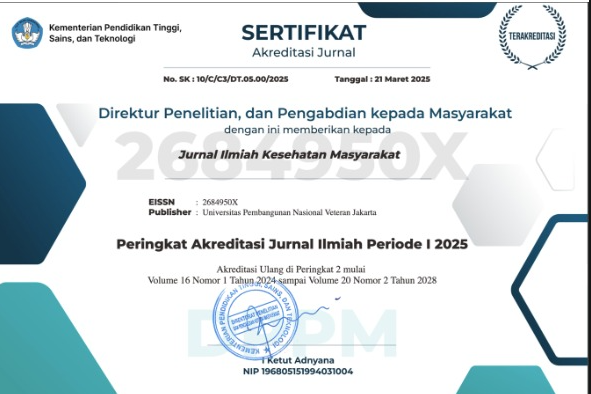Determinan Terjadinya Infeksi Saluran Kemih pada Pasien Dewasa di RSUD Kota Bekasi
Abstract
Latar Belakang: Infeksi saluran kemih (ISK) merupakan penyakit yang sering ditemukan di masyarakat dan Rumah Sakit. Juga biasanya dialami paling banyak pada wanita di bandingkan dengan laki-laki. Infeksi saluran kemih adalah infeksi yang terjadi di sepanjang saluran kemih, termasuk ginjal itu sendiri, akibat proliferasi suatu mikroorganisme. Faktor-faktor predisposisi dalam perkembangan infeksi saluran kemih dan pielonefritis kronik yaitu obstruksi saluran kemih, jenis kelamin, umur kehamilan, reflik vesikuler, peralatan kedokteran, kandung kemih neurogenik, penyalahgunaan analgesik secara kronik, penyakit ginjal, penyakit metabolik (diabetes,gout, batu). Penelitian ini bertujuan untuk mengetahui faktor-faktor yang mempengaruhi terjadinya infeksi saluran kemih di RSUD Bekasi pada pasien dewasa.
Metode: Penelitian ini dilaksanakan di RSUD Bekasi. Jenis penelitian yang digunakan adalah uji kohort Retrospektif. Sampel yang digunakan adalah Random Sampling 96 Responden. Data yang terkumpul memenuhi kriteria dianalisa secara univariat, bivariat menggunakan Chi Square, dan Multivatiat dengan regresi logistik.
Hasil: Hasil Penelitian ini menunjukan bahwa dari analisis multivariat ternyata variabel yang berhubungan bermakna dengan infeksi saluran kemih adalah jenis klamin, riwayat keluarga, penyakit urologi. Sedangkan variabel usia, dan penyakit metabolik sebagai perancu, namun hasil yang didapat dari odd ratio (OR) adalah penyakit metabolik yang paling besar dengan nilai 2,53, dan artinya pasien yang mengalami penyakit metabolik akan mengalami lebih besar dengan 2,5 lebih tinggi dibandingkan dengan pasien yang tidak mengalami penyakit metabolik.
Kesimpulan: Penyakit metabolik merupakan faktor yang paling mempengaruhi penyakit ISK
Background: Urinary tract infections (UTI) is a disease that is often found in community and hospital. Also usually experienced most common in females compared with males. Urinary tract infection is an infection that occurs in the urinary tract, including the kidney itself, due to the proliferation of a microorganism. Predisposing factors in the development of urinary tract infection and chronic pyelonephritis, urinary tract obstruction, sex, gestational age, reflik vesicular, medical equipment, neurogenic bladder, in chronic analgesic abuse, kidney disease, metabolic disease (diabetes, gout , stone). This study aims to determine the factors that influence the occurrence of urinary tract infections in hospitals Bekasi in adult patients.
Method: This study was conducted at Hospital Bekasi. Type of study is a retrospective cohort trial. The sample used was random sampling 96 respondents. The collected data meet the criteria analyzed in univariate, bivariate using Chi Square, and Multivatiat with logistic regression.
Result: The results of this study show that. From the multivariate analysis turns significant variables associated with urinary tract infection is a type of klamin, family history, urologic diseases. While the variables of age, and metabolic diseases as confounders, but the results obtained from the odds ratio (OR) is a metabolic disease with the greatest value of 2.53, and that means patients with metabolic disease will experience greater with 2.5 higher than with patients who did not experience disease metabolic.
Conclusion: Metabolic disease are the factors that most influence UTI
References
Black, J.M., & Hawks, J.H. (2009). Medical Surgical Nursing: Clinical Management for Positive Outcomes. (8th ed). Vol. 1. St. Louis: Elsevier
Haryono, Rudi . Keperawatan Madikal Bedah : Sistem Perkemihan. Jakarta: Rapha Publising.2013
Hooton, T.M., et. Al. Diagnoso, Prevention, and Treatment of Catheter Associated Urinary Tract Infection in Adults: 2009 International Clinical Practice Guidelines from the Infectious Disease Society of America, Guidelines Catheter Urinary. 2010. 625-663
Joon Ho Lee, dkk . Factors That Affect Nosocomial Catheter-Associated Urinary Tract Infection in Intensive Care Units: 2-Year Experience at a Single Center. Korea: Korea Jurnal Of Urologi. 2013
Komala, M dkk. Urinary Track Infection: Causes, Syntoms, Diagnosis And Its Management. Indian Jurnal Of Research In Pharmacy And Biotechnolgi. 2013. Volume 1 (2); NISN: 2320-3471
Laupland, B Kevin, dkk . Intensive Care Unit Aquired Urinary Track Infection In Regional Critical Care Sietem. 2005. Critical Care. Volume 9 No 2
Marlina, dkk. Hubungan Pemasangan Kateter Dengan Kejadian Infeksi Saluran Kemih Pada Pasien di Ruang Rawat Inap Penyakit Dalam RSUDZA Banda Aceh Tahun 2012. Jurnal Keperwatan Medikal Bedah.2013. Volume 1 No 1;35-47
Price, A Sylivia & Wilson, M Lorraine. . Patofisiologi: Konsep Klinis, Proses-Proses Penyakit. Edisi 6 Jakarta: EGC, 2006
Purnomo B ,Basuki (2011). Dasar-dasar Urologi edisi ketiga . Jakarta: Sagung Seto
Saptaningsih, Monica. Determinan Infeksi Saluran Kemih Pada Pasien Diabetes Mellitus Perempuan di RSB Bandung. Depok : Fakultas Ilmu Keperawatan Universitas Indonesia. 2012
Smeltzer, S.C., & Bare, B.G. (2008). Textbook of Medical Surgical Nursing. (8th ed). Vol.2. Philadelphia: Lippincott Williams &Wilkins
Soewondo, E.S. Penyakit Infeksi di Indonesia : Solusi Kini dan Mendatang. Surabaya: Airlangga University Press. 2007
Suharyanto, Toto & Madjid Abdul (2009). Diagnosa Keperawatan: Asuhan Kaperawatan Pada Klien Dengan Gangguan Sistem Perkemihan. Jakarta: TIM
Syella, Nafilah, dkk . Jumlah Bakteri Pada Pasien Dengan Kateterisasi Uretra di Bagian Bedah RSUD Ulin Banjarmasin Periode Mei-Agustus 2012. Bekala Kedokeran. 2013. Vol 9 No 1
Wibowo, Vincy Edy. Faktor Resiko, Pola Kuman, Dan Kepekaan Penyebab Bakterimia Pada Pasien Geriatri di Rumah Sakit Dr Kariadi Semarang. Semarang: Fakultas Kedokteran









.jpg)








